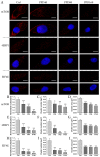Ginsenoside PPD's Antitumor Effect via Down-Regulation of mTOR Revealed by Super-Resolution Imaging
- PMID: 28335497
- PMCID: PMC6155369
- DOI: 10.3390/molecules22030486
Ginsenoside PPD's Antitumor Effect via Down-Regulation of mTOR Revealed by Super-Resolution Imaging
Abstract
Derived from Panax ginseng, the natural product 20(S)-Protopanaxadiol (PPD) has been reported for its cytotoxicity against several cancer cell lines. The molecular mechanism is, however, not well understood. Here we show that PPD significantly inhibits proliferation, induces apoptosis and causes G2/M cell cycle arrest in human laryngeal carcinoma cells (Hep-2 cells). PPD also decreases the levels of proteins related to cell proliferation. Moreover, PPD-induced apoptosis is characterized by a dose-dependent down-regulation of Bcl-2 expression and up-regulation of Bax, and is accompanied by the activation of Caspase-3 as well. Further molecular mechanism is revealed by direct stochastic optical reconstruction microscopy (dSTORM)-a novel high-precision localization microscopy which enables effective resolution down to the order of 10 nm. It shows the expression and spatial arrangement of mTOR and its downstream effectors, demonstrating that this ginsenoside exerts its excellent anticancer effects via down-regulation of mTOR signaling pathway in Hep-2 cells. Taken together, our findings elucidate that the antitumor effect of PPD is associated with its regulation of mTOR expression and distribution, which encourages further studies of PPD as a promising therapeutic agent against laryngeal carcinoma.
Keywords: PPD; antitumor; dSTORM; laryngeal cancer; mTOR.
Conflict of interest statement
The authors declare no conflict of interest.
Figures





Similar articles
-
20(s)-Protopanaxadiol (PPD) increases the radiotherapy sensitivity of laryngeal carcinoma.Food Funct. 2017 Dec 13;8(12):4469-4477. doi: 10.1039/c7fo00853h. Food Funct. 2017. PMID: 29090703
-
Plumbagin inhibits proliferation and induces apoptosis of hepatocellular carcinoma by downregulating the expression of SIVA.Drug Des Devel Ther. 2019 Apr 23;13:1289-1300. doi: 10.2147/DDDT.S200610. eCollection 2019. Drug Des Devel Ther. 2019. PMID: 31118568 Free PMC article.
-
20(S)-protopanaxadiol triggers mitochondrial-mediated apoptosis in human lung adenocarcinoma A549 cells via inhibiting the PI3K/Akt signaling pathway.Am J Chin Med. 2013;41(5):1137-52. doi: 10.1142/S0192415X13500778. Am J Chin Med. 2013. PMID: 24117074
-
Ginseng saponin metabolite 20(S)-protopanaxadiol inhibits tumor growth by targeting multiple cancer signaling pathways.Oncol Rep. 2013 Jul;30(1):292-8. doi: 10.3892/or.2013.2438. Epub 2013 Apr 30. Oncol Rep. 2013. PMID: 23633038 Free PMC article.
-
20(S)-Protopanaxadiol-Induced Apoptosis in MCF-7 Breast Cancer Cell Line through the Inhibition of PI3K/AKT/mTOR Signaling Pathway.Int J Mol Sci. 2018 Apr 2;19(4):1053. doi: 10.3390/ijms19041053. Int J Mol Sci. 2018. PMID: 29614812 Free PMC article.
Cited by
-
Therapeutic Potential of Natural Resources Against Endometriosis: Current Advances and Future Perspectives.Drug Des Devel Ther. 2024 Aug 21;18:3667-3696. doi: 10.2147/DDDT.S464910. eCollection 2024. Drug Des Devel Ther. 2024. PMID: 39188919 Free PMC article. Review.
-
Cancer chemoprevention and therapy using chinese herbal medicine.Biol Proced Online. 2018 Jan 8;20:1. doi: 10.1186/s12575-017-0066-1. eCollection 2018. Biol Proced Online. 2018. PMID: 29321719 Free PMC article. Review.
-
20 (S)-Protopanaxadiol Alleviates DRP1-Mediated Mitochondrial Dysfunction in a Depressive Model In Vitro and In Vivo via the SIRT1/PGC-1α Signaling Pathway.Molecules. 2024 Oct 28;29(21):5085. doi: 10.3390/molecules29215085. Molecules. 2024. PMID: 39519726 Free PMC article.
-
Harnessing the Power of Optical Microscopic and Macroscopic Imaging for Natural Products as Cancer Therapeutics.Front Pharmacol. 2019 Nov 28;10:1438. doi: 10.3389/fphar.2019.01438. eCollection 2019. Front Pharmacol. 2019. PMID: 31849680 Free PMC article. Review.
-
Polycaprolactone nanofibres loaded with 20(S)-protopanaxadiol for in vitro and in vivo anti-tumour activity study.R Soc Open Sci. 2018 May 2;5(5):180137. doi: 10.1098/rsos.180137. eCollection 2018 May. R Soc Open Sci. 2018. PMID: 29892448 Free PMC article.
References
-
- De Souza Viana L., de Aguiar Silva F.C., Andrade Dos Anjos Jacome A., Calheiros Campelo Maia D., Duarte de Mattos M., Arthur Jacinto A., Elias Mamere A., Boldrini Junior D., de Castro Capuzzo R., Roberto Santos C., et al. Efficacy and safety of a cisplatin and paclitaxel induction regimen followed by chemoradiotherapy for patients with locally advanced head and neck squamous cell carcinoma. Head Neck. 2016;38:E970–E980. doi: 10.1002/hed.24137. - DOI - PubMed
MeSH terms
Substances
LinkOut - more resources
Full Text Sources
Other Literature Sources
Research Materials
Miscellaneous

